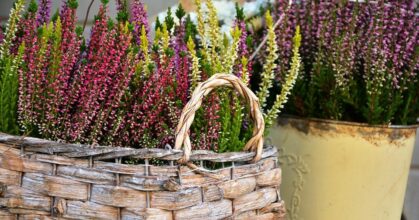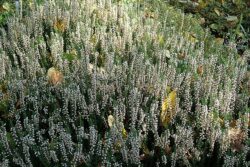In this article, we will be discussing how to grow Scottish heather or Callunas in containers. If you go to the Scottish highlands you will often see heathers growing but you wonder if they can be grown in containers. Calluna vulgaris is the sole species in the genus, a part of the Ericaceae family. It has many common names such as common heather, ling plant heather, Scottish heather.

It is native to Europe, where dwarf heathers are grown for its flowers that appear in later summer and autumn and sometimes for its colourful foliage that appear in late autumn and winter. The flowers are often pink, white or mauve, where in its native habitat a mass of blooms can be enjoyed on top of the barely noticeable leaves. The flowers tend to appear on one side, where capsule berries soon follow.
If you get the acidic growing conditions right, it can grow up to 60cm in height and 60cm in its spread. The foliage is often dense and compact, making it an excellent ground cover plant. It may surprise to know but 800 cultivars exist. Some as said earlier are grown for their flowers whilst others are grown for their autumn foliage.
It is a frost-hardy plant so you do not need to worry about any winter protection, but one thing it does not like is high humidity or hot summers. Plant it in full sun where it will appear at its best. In a hot summer heatwave, it is advised to move the container to partial shade to protect the plant from the strong and hot midday sun.
SOIL AND COMPOST
You do not need to use a large container but large enough to display the plant in. Callunas like well-drained, ericaceous compost that retains plenty of moisture. This will not only keep the plant in plenty of moisture but will also keep the roots cool and from overheating.
The ideal; pH is between 4.5 and 5.5, so do not add any lime and be careful to make sure the pH does not decrease over time. This is why it is recommended to water them with rainwater that is naturally acidic and not tap water, especially if you live in a hard water area.
THEY ARE SHALLOW-ROOTED
Callunas have shallow roots and so transplanting must be done carefully. Place the plant in the container and make sure that the roots are broken so that they are not circulating at the bottom. After the plant has been firmly positioned in the container, mulch around the plant with pine bark as this will not only suppress any weeds from growing but will also help the plant retain moisture.

You will need to water at least once or twice a week, ensuring the compost is never allowed to dry out, but never too soggy. Too much water can lead to root rot and the plant will not do too well. Once the plant is established, you will need to water it less frequently but still making sure that the compost is moist at all times.
Scottish heathers do not need fertilizing as they prefer poor soils and compost naturally. If after a while your plant depletes all the elements available to it and it is showing a deficiency that affects the health and looks of the plant, it is time to give a feed. Feed with a liquid ericaceous fertilizer suitable for acid-loving plants only once during the growing season. No more than this as it will not benefit the plant in the long run.
HOW TO MAINTAIN A SCOTTISH HEATHER
Heathers responds well to pruning and in early spring give it a haircut to remove all the old spent flowers. This will encourage more lush growth and better flowering later on in the growing season in late summer. Pruning is also important to prevent the plant from becoming leggy and straggly.
PESTS AND DISEASES
If you do not protect from the hot summer sun, heathers can get root rot and die. It may also suffer from spider mites and some form of scale insects, so be prepared to deal with these as soon as they are noticed by using suitable systemic insecticide.
WHAT VARIETIES TO GROW

Two of the best matting types of Callunas are ‘Robert Chapman’ and ‘Wickwar Flame’ that go from a gold colour through orange to red in the winter months. A plant that also is golden is ‘Seastar’. ‘Silver Queen’ have a downy coating that makes it appear silver-grey that appears as a perfect foil for its mauve flowers. ‘Spring Cream’ has creamy new growth in spring and makes a great alternative to the others.
A more compact variety is Calluna vulgaris ‘Skyline Series Stockholm‘ that has pretty pink flowers. As said earlier you do have a wide choice and so many different cultivars that can be grown in containers, so do not be too conservative in your approach to what plants can be used in your design.
CONCLUSIONS
In this article, we have discussed how to grow Calluna in containers from the type of compost to use, preferred growing conditions and what varieties to grow. They tend to be easy plants to look after and grow and you should not have too many problems as long as you prune lightly in early spring and make sure the compost is never too dry.
You have plenty of choice as to what variety that you can grow with different flower colours and leaf changes in late autumn and in winter.
If you have any questions or comments that you wish to make on growing Scottish heather in containers, please do so in the comment box below.
Happy Calluna growing.
